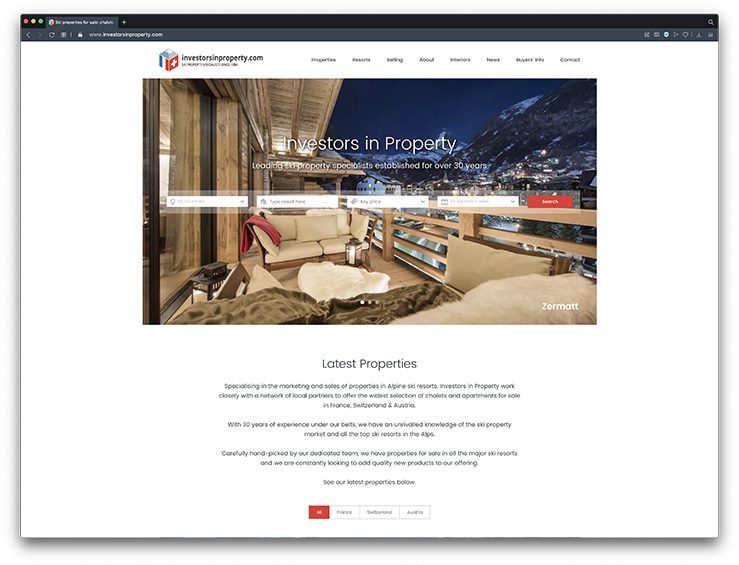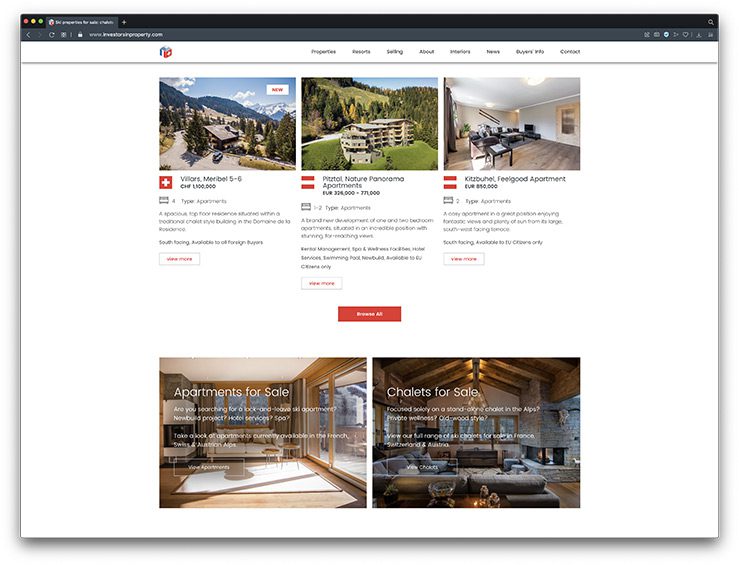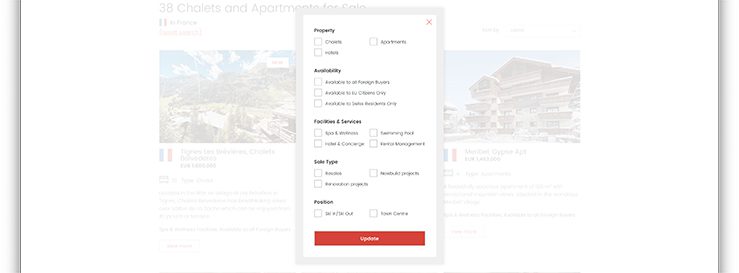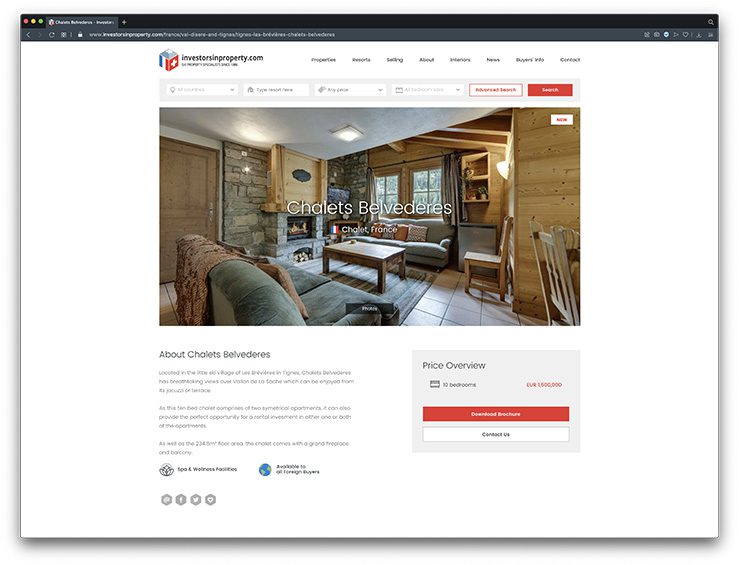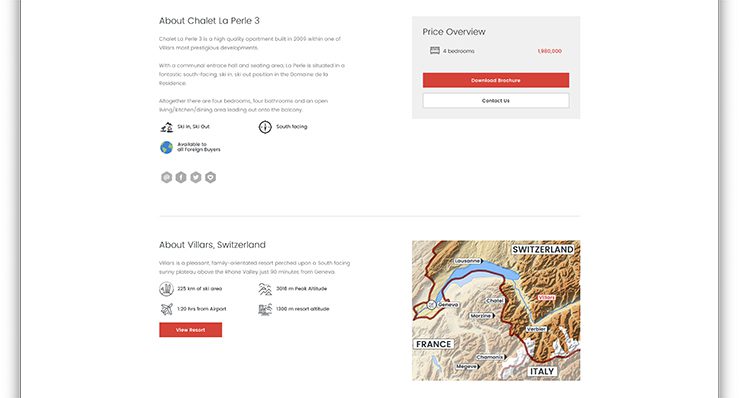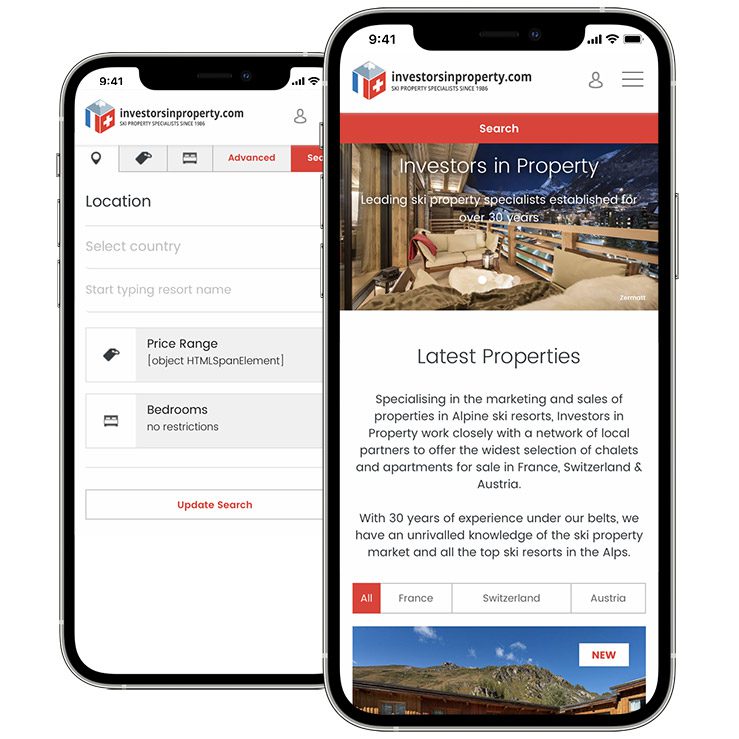
Article
Our Best Resort Website Design & Development Tips
PUBLISHED:October 18, 2021
UPDATED:April 2, 2024
In the third of our articles looking at types of property websites, we’ll be taking a closer look at Resort Website Design & Development.
Resort websites exist to help customers find holiday homes and second homes in key locations around the world.
These resorts are often centred around a particular activity or lifestyle, such as skiing, desert island escapes and sometimes inner-city living.
The type of home for sale varies from small apartments to large 10-bed chalets, farmhouses and beach houses.
Resort Website Design
The purpose of a resort website is to attract high-net-worth individuals who wish to invest in luxury properties. They are looking for second homes in beautiful locations, which they can use for vacations or as a business stop-over.
This demographic is used to living the high life, so the design of any resort website needs to reflect this level of living.
Ski resort website design case study
Investors in Property are specialists in selling ski properties throughout France, Switzerland and Austria.
Towards the end of 2017, IIP contacted our sister agency, Devstars, to discuss a redesign of their website, which they were finding hard to manage and were convinced could work better for them in terms of driving sales.
And so, throughout early 2018, DevStars and LWDA set about planning the redesign & rebuild of this specialist ski resort website.
Working directly with the client, we identified the key website improvements they were looking for:
-
- Reduced management time
- Improved user journey
- Improve site search
- Drive more sales enquiries
- More detailed property listings
- Improved SEO
- Faster page-load times
- Improved mobile experience
Let’s take a look at each of these in more detail…
Reduce Website Admin Time
IIP’s old website was built with no CRM integration at all, so the team had to input data twice. Once into Salesforce (their property management tool) and again into the website.
This method of website management was wasting valuable time that could be better used in dealing with enquiries, so our first task was to streamline this process.
Working with our own Salesforce specialist we optimised their setup.
We stripped away Propertybase – which was overcomplicated and unnecessary – and integrated Salesforce directly into WordPress using a custom-built API.
This meant that the team would only input property details once into Salesforce. The CRM would then automatically populate the website. No double data entry is required.
Improved User Journey
In order to improve the user journey, you must first fully understand the different types of users.
Who are your users and what are they expecting to get from your website? What are the primary goals for your users and what tasks do you want your users to complete?
Detailing these requirements helps us correctly structure each type of web page. We can then maximise the chance that a user will follow the path you want them to follow, whilst also feeling that they are getting to their destination quickly, within as few clicks as possible.
The trick is to place the correct tools and messages on the right parts of the page. Remove all unnecessary CTAs and keep your users’ attention focused on the task they are trying to complete.
Only if a user scrolls to the bottom of a page without performing any interaction should you then provide additional tools and info to help keep them on the site and guide them to rewarding content.
Sticky navigation is also a great help when trying to improve the user journey and overall website UX.
Improved Site Search
The key to any property website is allowing the user to find the kind of property they are looking for as quickly and easily as possible.
In order to facilitate this, you need to develop search tools that allow the user to refine results using a range of filters.
Resort websites can contain a wide range of data types. Developing a search tool that allows for filtering by all of these options would likely result in an overwhelming experience for the user and so be counterproductive.
With this in mind, we developed a two-tier search method.
The sites’ navigation houses the main search tool, which allows for filtering by the following data types:
- Locality
- Resort name (if known)
- Price (including 3 different currency options)
- Number of bedrooms
Once the user has reviewed their results, they can refine them further by using the Advanced Search function.
The Advanced Search function allows for additional filtering by:
- Property type (Chalet, etc)
- Availability (EU citizens only, etc)
- Facilities & Services (Spa, Swimming Pool, etc)
- Sale Type (Resales, Newbuilds, etc)
- Position (Ski in/Ski out, Town Centre, etc)
Offering the user this level of control over their property searches leads to greater user satisfaction and a higher rate of enquiries.
Drive more sales enquiries
Once you have helped your user find their ideal property, you need to make it easy for them to make an enquiry.
This sounds simple enough, but it’s always amazing to see websites that make the user scroll manually all the way to the bottom of a page before they can obtain contact info.
Our solution is to offer the user the ability to get in touch at a much earlier part of the journey (towards the top of the page) and then repeat the CTA at the bottom.
Longer pages may require even more contact CTAs to help boost enquiries.
To help drive enquiries, make sure that the CTA is obvious enough. Use colour and size to help the CTA stand out on the page.
More detailed property listings
To echo what was covered in our Best Estate Agent Website Design Tips article, we advise all resort website owners to include as much detail about their properties on the site as possible.
It can be very frustrating for a potential buyer to visit a site and feel like they don’t have enough information to make an informed purchase choice at that stage.
Although you may want to encourage enquiries, doing so by withholding too much information will often work against you.
Openness builds confidence, so make sure you include as many property details in your listings as possible.
Resort details may include:
- A well-written description that creates desirability
- Price
- Number of bedrooms
- Locality (including Google map)
- Facilities
- Local Amenities
- Distance from airport
- Weather conditions
- Brochure download in PDF format
If a buyer wishes to know more about the property after reviewing the details on your site, they will simply get in touch, which is what you want them to do anyway.
Improved SEO
Probably high on this list for any website owner is improved SEO. Especially when investing in a re-design and re-build of an existing website.
No site owner wants to see their current search engine rank fall, and if anything they want to see a steady improvement over time.
To help achieve this, an effective SEO strategy should be planned early in the project.
Key aims and corresponding actions should be listed within a document and agreed upon by all parties before the design stage commences.
Aims and actions may include some of the following:
- Better structuring of page URLs
- Re-directing of old URLs to new pages
- 404 page to catch mistyped URLs
- Better data structuring, including schema tags to help Google index pages better and rank them higher
- Improved off-site SEO using Google My Business and social media channels
For resort websites that focus on particular localities, their SEO efforts should be concentrated on those areas. This is often referred to as Local SEO.
Including some form of news blog on your site is probably the single most effective way to improve SEO.
Blogging allows for the creation of keyword-focused content that search engines such as Google pick up and suggest to potential buyers.
Faster page-load speed
SEO is a term often used as shorthand for ‘content strategy’, but is actually a much broader subject that includes site speed.
Google has included site speed as a ranking factor for some years, so it’s important that your site loads quickly.
If your site is slow to load, not only will Google penalise your ranking, but users are likely to leave your site early in their journey due to being frustrated with slow page-load speeds.
Faster page-load speeds can be achieved with the following actions:
- A minimal approach to coding (less code = faster browser rendering)
- Optimised images using tinypng & tinyjpg
- A fast hosting package with dedicated servers to deliver your site pages worldwide as quickly as possible
- A CDN (Content delivery network) that maximises your efforts with point no.3
- Use fewer plugins and external Javascript calls
There are other actions that you can take if your site is still running slowly, but incorporating the above list into your SEO strategy will in turn improve overall site speed.
Improved mobile experience
And finally on our list of requirements for Investors in Property was an improved mobile experience.
It’s easy to take it for granted these days that almost all websites are responsive to mobile devices, but there are still a few out there that are lacking this functionality, or need their mobile experience improved.
Mobile devices can easily account for over 60% of site visitors and this figure is only set to rise, so there is a high chance that your target audience is using a mobile device to access your site.
With this in mind, a mobile-first design strategy is a must. At the very least, tackling website design across all platforms (desktop, tablet & mobile) at the same time is required.
We tackle the mobile experience at the earliest stage of the process when looking at wireframes. This way, we have a very clear idea of how the website is going to work on mobile before we even get to the design phase.
Investing time during these early stages of the project helps avert disappointment further down the line.
In conclusion
If you have been following this series of articles on property website design, you’ll have started to see some common themes emerging.
Client requests that include reduced admin time, improved UX, increasing enquiries and better SEO seem to be universal, but each type of site does also have its own unique set of requirements.
Something that we haven’t really touched on before is that investing time during the early stages of the project will save you time and stress further down the line.
We understand the temptation to dive straight into the design phase of the project. After all, it is with our eyes that we tend to judge the success of a design project. But resisting this urge and allowing for some time at the start of the project to detail the requirements and explore options with wireframing will be time well spent.
We’ll be taking a closer look at our processes in a future article.
Until next time…
We hope that you found this article useful as a guide to helping create an effective resort website.
If you’re looking to have a new website designed & built for your property company, please feel free to get in touch with us at LWDA to discuss your needs.
We’re always happy to listen and will be open and honest with our advice.
Property Website Design Articles
This article about Resort Website Design was the third of four posts in a series focussing on various types of property website design.
The other articles are as follows:
- Estate Agent Website Design & Development Tips
- Real Estate Website Design & Development Tips
- Holiday Home Website Design & Development Tips
We hope that you find these articles helpful and look forward to hearing from you in the future if you’re a property website owner in need of website design services.
In the meantime, feel free to follow us on LinkedIn, Twitter or Facebook for more insights.


